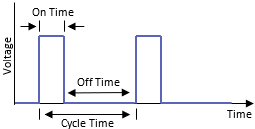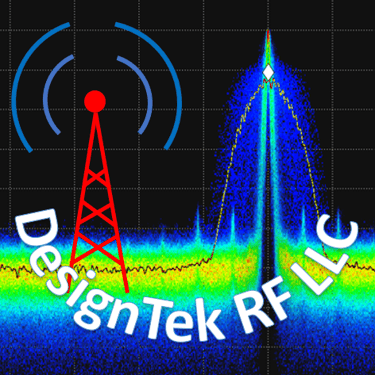Resources to help protect your fisheries
Battery Requirements
The battery requirements are largely determined by the average probe current. Batteries are rated in terms of AH (Amp Hours). This is the amount of current a battery can deliver over the period of 1 hour. For example, if the battery has a 10 AH rating, then the battery could deliver 10 Amps of current for 1 hour, 1 Amp for 10 hours, or 0.1 Amps for 100 hours. Typically, battery manufactures specify the battery at a 20-hour rate. When current is drawn faster than that generally the actual AH capacity of the battery is less than the 20-hour rate.
First the duty cycle of the probe pulse must be understood the probe load current can be determined.
Duty Cycle is the ratio of the probe On Time to the total time of the cycle which is the On Time plus the Off Time. For the snail barrier the On Time has internally been defined to be 25 milliseconds (ms) and the Off Time has been set to 3 seconds (s). This value is not adjustable by the user.
Duty Cycle = On Time / (On Time + Off Time) x 100% (1)
Barrier Duty Cycle = 0.025 s / (0.025 s + 3 s) x 100% = 0.8264% or 0.008264
The worst-case probe load current is equal to the peak current draw multiplied by the duty cycle.
Probe Load Current(worst case) = Peak Probe Current * Duty Cycle (2)
To determine the total supply current required find the worst-case average probe load current and add it to the quiescent barrier current. This will give the total average current that needs to be supplied by the battery on a continuous basis.
Total Supply Current = Probe Load Current(worst case) + Quiescent Barrier Current (3)
To determine the capacity requirement of the battery the user must consider a worst-case charging scenario where the battery would need to supply the total current in the absence of being charged. Battery ratings generally degrade with time so some margin should be added to the capacity to account for this degradation over time.
Battery Capacity = Total Supply Current x Number of Hours without Charging (4)
The peak current capacity of the battery should also be considered. Even though the average current may be small enough to be powered by a very small battery this battery may not have the ability to provide large peak currents.


Example
Calculate the battery size for the following situation:
· Worst-case probe current is 2.0 Amps at 12 Volts
· Number of days without charging is 7 days
1. Calculate the worst-case average probe current by using equation (1). Use the Duty Cycle calculated in the prior section.
Probe Load Current(worst) = 2.0 A x 0.008264 = 0.0165 A or 16.5 mA
2. Calculate the total supply current using equation (3).
Total Supply Current = 16.5 mA + 35 mA = 51.5 mA ~ 52 mA
Remember: The 35 mA current draw is what it takes to run the controller and display on a continual basis.
3. Calculate the battery capacity using equation (4).
Battery Capacity = 0.052 A x 7 days x 24 hours/day = 8.736 AH (Amp Hours)
Allowing some margins the choice would probably be a 9 or 10 AH battery.
The following batteries would be a good choice.
Grainger 12 V Sealed Lead Acid Batteries
Power Sonic also has great Sealed Lead Acid Batteries
Creative solutions for aquatic ecosystem preservation.
© 2025. All rights reserved.
